As widely broadcast, Curiosity just used its rotating brush to clean a spot near the “Snake River” site. Here is a spherical panorama of the site made from sol 151 Navcam images: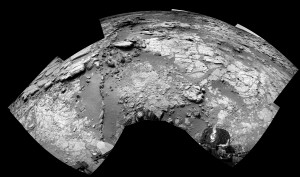
The front of curiosity is at the bottom left, where you can see the round sample tray, and below that, the drill bit holder. I presume the little flared cones are to receive the drill so it can grasp and withdraw a drill bit. I had to coax this image into the curved shape you see using the panorama editor in PTgui ( you just click and drag ) but the front and back wheels are still not parallel. They do turn, of course, but anyway if I tried to make them straight the scene became too distorted.
At the JPL Sol 150 Mastcam raw image page you can see a variety of images of the brushed spot. I believe the color images are made from Red, Green, and Blue filtered images, as opposed to using color sensors in the camera. We can infer that the spot, which is bright bluish white iin color, is dark in the raw red filtered B&W images, and bright in the blue images. Actually, in red it appears only slightly darker than the omnipresent red dust.
In the Navcam view, it is very hard to discern, even though it is fairly large, just in front of the sample tray. Compare this thumbnail ( linked from the MSL site ) to a ( clickable ) excerpt from the panorama I made, rotating it in paint.net to match the orientation:
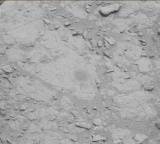
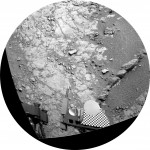
Update: In the last two days Curiosity has moved forward a few feet, and the Navcam procided the images for this panorama on sol 153 :
Here you can see all three wheels on the right side, and the front “spoiler”, so the panorama is lined up pretty well. Note the right middle wheel is sitting right on top of the signature “Snake River” rock formation. All glory is fleeting. Just ahead of Curiosity, you can see a large rock at the left of the panorama, sort of a disk. It’s also visible in the sol 151 Navcam panorama above, and is featured in the following very nice sol 153 Mastcam panorama. When I made this one it came in at about 27 Meg, well above the 20 Meg upload limit. I was going to reduce it using Paint.net, but when I went to write it out I noticed it was saying 18 Meg at 100% resolution. Nevertheless, I reduced the “quality” to 70% and the size came down to 3 Meg, and it still looks good.
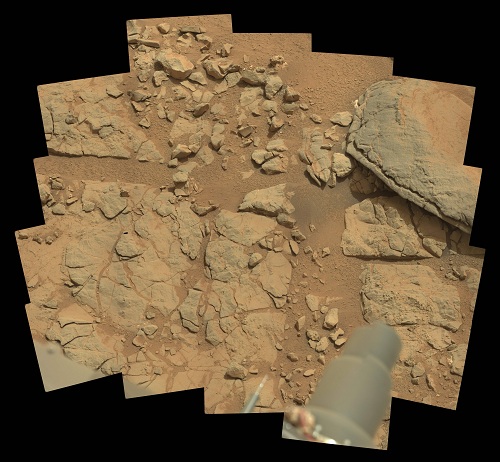
Update 2 : There are some sol 154 MAHLI images which are include closeups of locations within this panorama. Here is a “key” with one of the locations cicled in blue, along with an enlargement which has been rotated to match the MAHLI image orientation. ( Click it to see full resolution. )

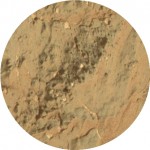
Here is a panorama consisting of two MAHLI images spanning this location. Note how PTgui warped them to get a match. ( Click for full resolution. )
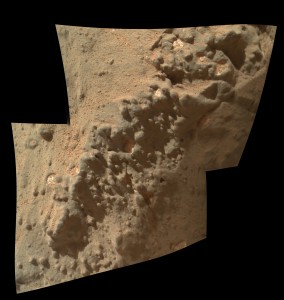
So, what is this stuff? Is it something of special interest? The JPL Curiosity site is still touting the brushmark as the latest thing. They are ostensibly looking for a place to try the drill, AFAIU, but maybe they are just sight-seeing. They also say Curiosity is about to head for Mt. Sharp, but they are still dawdling around in Yellowknife Bay.
A note on the appellation of “Snake River”: Between this and “Yellowknife Bay”, I’m wondering if we don’t have the influence of some outdoorsy type who has familiarity with these namesakes. I was thinking that the Martian Snake River was not the rocks per se, but the “canyon” which wends its way down to them. These rocks could be “The Pillars” on the Snake River, just below Evel Knievel’s jump site, as a matter of fact:
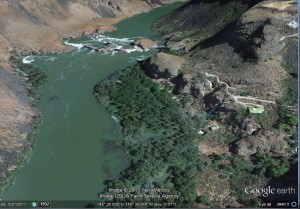

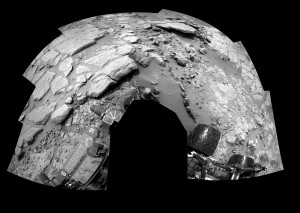
Nice images! Have they reported any more about the so-called “flower” they found at this site? I haven’t seen anything about it since the initial shots came out. I’m guessing it is just an interesting looking feature of an otherwise normal rock, and not worth investigating any further…
http://photoblog.nbcnews.com/_news/2013/01/03/16329185-curiosity-rover-studies-rocks-and-a-flower-on-mars?lite
It sure looks like another piece of wire wrap to me. I stumbled across the web offering identifying it as a flower, with music, and I assumed it was a retread of the earlier incident which was more or less owned up to by JPL. That was at “Rocknest” when they were trying our their shovel scoop, but of course it is noticeably different, although quite similar, so I assume they are having a similar “issue” hah, hah, with the first use of the drill. Not what they want, but the robot arm is bristling with this stuff. It gets real cold there at night and I guess it gets brittle. Ooch. Somebody’s sweating over this, I’m sure.
On second thought! … it doesn’t really look like the wrapper from sol 65 at all. They had a MAHLI closeup of that where you could see it very clearly. This”flower” just has that shiny, pearly texture that is suggestive of plastic wrap. Suveying the sol 132 MAHLI image that contains it, I can see other formations which have a similar vitreous appearance, but none of them have that pearly white color. Plus, I saw a news item saying that NASA had identified it as a natural formation. Some of the other “blobs” suggest to me they might be some kind of molten splash from an impact. I have thought that a lot of what we see is due to small impacts. It’s a strange place.